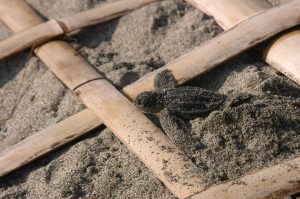Conservation Projects

Leatherback hatchling (photo credit: Nicolas Pilcher, MRF)
The Council established the Sea Turtle Conservation Program in 2002 to ensure the sustainability of Hawai‘i-based longline fisheries, contribute to the international transfer of sustainable fisheries technology and knowledge, and aid in the recovery of Pacific sea turtle populations. Since then, the Council has successfully fostered collaboration, transferred bycatch mitigation technology, and convened a number of international meetings. The Council has also supported sea turtle research, monitoring, and conservation projects in the Pacific where funding may not have been otherwise available.
Prior to 2001, the Hawai‘i-based longline fishery had annual interaction levels of approximately 400 loggerhead turtles and 100 leatherback turtles. The temporary closure of the shallow-set swordfish fishery over concerns of turtle interactions brought about the immediate need to develop effective solutions to reduce turtle interactions while maintaining the viability of the industry. Since the reopening of the swordfish sector in 2004, the fishery has operated under strict management measures, and sea turtle interactions in the swordfish fishery have decreased by nearly 90% (Gilman et al. 2007).
Recognizing that reducing sea turtle interactions in Hawai‘i-based fisheries alone will not be enough to recover sea turtle populations in the Pacific, the Council has played an active role in transferring mitigation technology to international fisheries through a variety of international channels. In addition, the Council has supported nesting beach and foraging ground conservation projects. These projects have increased hatchling production and reduced mortality, and data from the projects have improved population baseline data for the Biological Opinions under the ESA Section 7 consultation process.
The following is a summary of projects that the Council has supported over the years:
International Transfer of Mitigation Technologies
In 2000, the Council adopted a resolution calling for international cooperation to assess fishery takes and to develop mitigation programs to reduce interactions Pacific-wide. This resolution prompted a decade-long effort to exchange information and technology on an international scale.
- International Fishers Forum (2002–2010)
- Latin American Gear Technology Exchange (2004–2007)
- Technical Workshop on Mitigating Sea Turtle Bycatch in Coastal Net Fisheries (2009)
Nesting Beach Monitoring, Management and Conservation
The Council has supported a variety of sea turtle monitoring and management efforts across the Pacific basin. These projects are implemented by local, community-based NGOs.
- Leatherback Turtle Conservation at Wermon Beach, Papua, Indonesia (2003–2009)
- Leatherback Turtle Conservation at Huon Coast, Papua New Guinea (2003–2014)
- Loggerhead Turtle Conservation in Japan (2004–2013)
- Leatherback Turtle Conservation in Manokwari Region, Papua, Indonesia (2010–2012)
- Socioeconomic Research and Capacity-Building to Strengthen Conservation of Western Pacific Leatherback Turtles in Papua Barat, Indonesia (2010–2012)
Fisheries Impacts Mitigation
The Council has supported research and monitoring projects that aim to study and reduce sea turtle bycatch rates.
- Loggerhead Bycatch Reduction, Baja California Sur, Mexico (2004–2012)
- American Samoa Longline Fishery Circle-Hook Study (2010)
Databases and Assessments
Standardization and dissemination of data, as well as population-level studies, are important for the monitoring and management of sea turtles at an international level.
